A Quantitative Review of Irrigation Development in the Yazoo–Mississippi Delta from 1991 to 2020
Abstract
:1. Introduction
2. Materials and Methods
2.1. Data Sources
2.1.1. Government Surveys
2.1.2. Geospatial Datasets
2.2. Processing and Analysis
3. Results and Discussion
3.1. Irrigated Area
3.1.1. Growth Rate
3.1.2. End-of-Period Snapshot
3.1.3. Spatial Autocorrelation
3.2. Irrigated Land Cover
3.2.1. Temporal Trends in Full-Delta Counties
3.2.2. End-of-Period Snapshot
3.2.3. Comparison against Never-Permitted Land
3.3. Irrigation Systems
3.3.1. Water Sources
3.3.2. Energy Sources
3.3.3. Application Methods
4. Conclusions
Author Contributions
Funding
Institutional Review Board Statement
Informed Consent Statement
Acknowledgments
Conflicts of Interest
References
- Galloway, G.E., Jr. Ex Post Evaluation of Regional Water Resources Development: The Case of the Yazoo-Mississippi Delta; IWR-80-D1; United States Army Corps of Engineers: Belvoir, VA, USA, 1980. [Google Scholar]
- Snipes, C.E.; Nichols, S.P.; Poston, D.H.; Walker, T.W.; Evans, L.P.; Robinson, H.R. Current Agricultural Practices of the Mississippi Delta; Bulletin 1143; Mississippi Agricultural & Forestry Experiment Station: Starkville, MS, USA, 2005. [Google Scholar]
- Yazoo Mississippi Delta Joint Water Management District. Water Management Plan; Yazoo Mississippi Delta Joint Water Management District: Stoneville, MS, USA, 2006. [Google Scholar]
- Massey, J.H.; Stiles, C.M.; Epting, J.W.; Powers, R.S.; Kelly, D.B.; Bowling, T.H.; Janes, C.L.; Pennington, D.A. Long-term measurements of agronomic crop irrigation made in the Mississippi delta portion of the lower Mississippi River Valley. Irrig. Sci. 2017, 35, 297–313. [Google Scholar] [CrossRef]
- Arthur, J.K. Hydrogeology, Model Description, and Flow Analysis of the Mississippi River Alluvial Aquifer in Northwestern Mississippi; Water-Resources Investigation Report 2001–4035; United States Geological Survey: Pearl, MS, USA, 2001. [Google Scholar]
- USGS Groundwater Watch: Mississippi River Valley Alluvial Aquifer. Available online: https://groundwaterwatch.usgs.gov/netmapT2L1.asp?ncd=MRA (accessed on 24 September 2021).
- Killian, C.D.; Asquith, W.H.; Barlow, J.R.B.; Bent, G.C.; Kress, W.H.; Barlow, P.M.; Schmitz, D.W. Characterizing groundwater and surface-water interaction using hydrograph-separation techniques and groundwater-level data throughout the Mississippi Delta, USA. Hydrogeol. J. 2019, 21, 2167–2179. [Google Scholar] [CrossRef] [Green Version]
- Haugh, C.J.; Killian, C.D.; Barlow, J.R.B. Simulation of Water-Management Scenarios for the Mississippi Delta; Scientific Investigations Report 2019–5116; United States Geological Survey: Reston, VA, USA, 2020. [Google Scholar]
- Yasarer, L.M.W.; Taylor, J.M.; Rigby, J.R.; Locke, M.A. Trends in land use, irrigation, and streamflow alteration in the Mississippi River Alluvial Plain. Frontiers Environ. Sci. 2020, 8, 66. [Google Scholar] [CrossRef]
- Census of Irrigation. Available online: https://www.nass.usda.gov/Surveys/Guide_to_NASS_Surveys/Farm_and_Ranch_Irrigation/index.php (accessed on 25 June 2021).
- Census of Agriculture. Available online: https://www.nass.usda.gov/AgCensus/ (accessed on 11 September 2021).
- Major Land Resource Area (MLRA) Geographic Database, Version 4.2. Available online: https://www.nrcs.usda.gov/wps/portal/nrcs/detail/soils/survey/?cid=nrcs142p2_053624 (accessed on 20 July 2021).
- County Boundaries for Mississippi (2015). Available online: https://www.maris.state.ms.us/HTML/DATA/data_Boundaries/CountyBorders.html (accessed on 12 July 2021).
- State Soil Geographic (STATSGO) Data Set. Available online: https://www.maris.state.ms.us/HTML/DATA/data_Geoscience/StatewideSoils.html (accessed on 12 July 2021).
- CropScape—Cropland Data Layer. Available online: https://nassgeodata.gmu.edu/CropScape/ (accessed on 12 July 2021).
- Mississippi Commission Environmental Quality Surface Water Groundwater Use and Protection Regulations. Available online: https://www.mdeq.ms.gov/wp-content/uploads/2017/06/11-Miss.-Admin.-Code-Pt.-7-Ch.-1.pdf (accessed on 5 October 2021).
- Harris, C.R.; Millman, K.J.; van der Walt, S.J.; Gommers, R.; Virtanen, P.; Cournapeau, D.; Wieser, E.; Taylor, J.; Berg, S.; Smith, N.J.; et al. Array programming with NumPy. Nature 2020, 585, 357–362. [Google Scholar] [CrossRef]
- Bivand, R.S.; Wong, D.W.S. Comparing implementations of global and local indicators of spatial association. Test 2018, 27, 716–748. [Google Scholar] [CrossRef]
- Gräler, B.; Pebesma, E.; Heuvelink, G. Spatio-Temporal Interpolation using gstat. R J. 2016, 8, 204–218. [Google Scholar] [CrossRef]
- Climate Data Online. Available online: https://www.ncdc.noaa.gov/cdo-web/ (accessed on 30 October 2021).
- Mabry, S.; Mississippi Department of Environmental Quality, Jackson, MS, USA. Personal communication, 2021.
- SoilWeb: An Online Soil Survey Browser. Available online: https://casoilresource.lawr.ucdavis.edu/gmap/ (accessed on 27 September 2021).
- Yazoo Mississippi Delta Joint Water Management District. 2011 Annual Report. Yazoo Mississippi Delta Joint Water Management; District: Stoneville, MS, USA, 2012. [Google Scholar]
- Stanturf, J.A.; Gardiner, E.S.; Hamel, P.B.; Devall, M.S.; Leininger, T.D.; Warren, M.E. Restoring bottomland hardwood ecosystems in the Lower Mississippi Alluvial Valley. J. For. 2000, 98, 10–16. [Google Scholar] [CrossRef]
- Grim, V. The High Cost of Water: African American Farmers and the Politics of Irrigation in the Rural South, 1980–2000. Agric. Hist. 2002, 76, 338–353. [Google Scholar] [CrossRef]
- Reba, M.L.; Massey, J.H. Surface irrigation in the Lower Mississippi River Basin: Trends and innovations. Trans. ASABE 2020, 63, 1305–1314. [Google Scholar] [CrossRef]
- Brock, M.L. Analysis of Surface Water for Irrigation in the Big Sunflower River Watershed. Master’s Thesis, Mississippi State University, Starkville, MS, USA, 2021. Available online: https://scholarsjunction.msstate.edu/td/5086/ (accessed on 14 September 2021).
- Quintana-Ashwell, N.; Gholson, D.M.; Krutz, L.J.; Henry, C.G.; Cooke, T. Adoption of Water-Conserving Irrigation Practices among Row-crop Growers in Mississippi, USA. Agronomy 2020, 10, 1083. [Google Scholar] [CrossRef]
- Los Angeles, CA Ultra-Low Sulfur CARB Diesel Spot Price. Available online: https://www.eia.gov/dnav/pet/hist/LeafHandler.ashx?n=pet&s=eer_epd2dc_pf4_y05la_dpg&f=m (accessed on 13 September 2021).
- Average Retail Price of Electricity, United States, Monthly. Available online: https://www.eia.gov/electricity/data/browser/#/topic/7 (accessed on 13 September 2021).
- Mont Belvieu, TX Propane Spot Price FOB. Available online: https://www.eia.gov/dnav/pet/hist/eer_epllpa_pf4_y44mb_dpgM.htm (accessed on 13 September 2021).
- Yanik, K. Propane Poised to Overtake Diesel Engines on the Farm. Available online: https://www.lpgasmagazine.com/irrigation-transformation-propane-poised-to-overtake-diesel-engines-on-the-farm/ (accessed on 28 September 2021).
- Salassi, M.E.; Musick, J.A.; Heatherly, L.G.; Hamill, J.G. An Economic Analysis of Soybean Yield Response to Irrigation of Mississippi River Delta Soils; Mississippi Agricultural & Forestry Experiment Station: Starkville, MS, USA, 1984. [Google Scholar]
- Heatherly, L.G.; Pringle, H.C. Soybean Cultivars' Response to Flood Irrigation of Clay Soil. Agron. J. 1991, 83, 231–236. [Google Scholar] [CrossRef]
- Laws, F. Irrigation: A Game-Changer for Mid-South Agriculture. Available online: https://www.farmprogress.com/irrigation-systems/irrigation-game-changer-mid-south-agriculture (accessed on 7 October 2021).
- Kaur, G.; Singh, G.; Motavalli, P.P.; Nelson, K.A.; Orlowski, J.M.; Golden, B.R. Impacts and management strategies for crop production in waterlogged or flooded soils: A review. Agron. J. 2020, 112, 1475–1501. [Google Scholar] [CrossRef] [Green Version]
- Solomon, K.H.; El-Gindy, A.M.; Ibatullin, S.R. Planning and System Selection. In Design and Operation of Farm Irrigation Systems; Hoffman, G.J., Evans, R.G., Jensen, M.E., Martin, D.L., Elliott, R.L., Eds.; American Society of Agricultural and Biological Engineers: St. Joseph, MI, USA, 2007; pp. 57–75. [Google Scholar]
- Pringle, H.C., III; Martin, S.W. Cotton yield response and economic implications to in-row subsoil tillage and sprinkler irrigation. J. Cotton Sci. 2003, 7, 185–193. [Google Scholar]
- Pringle, H.C., III; Ebelhar, M.W.; Martin, S.W. Yield, and economic response of cotton to in-row deep tillage and furrow irrigation in a corn/cotton rotation on a silty clay loam soil. J. Cotton Sci. 2008, 12, 331–344. [Google Scholar]


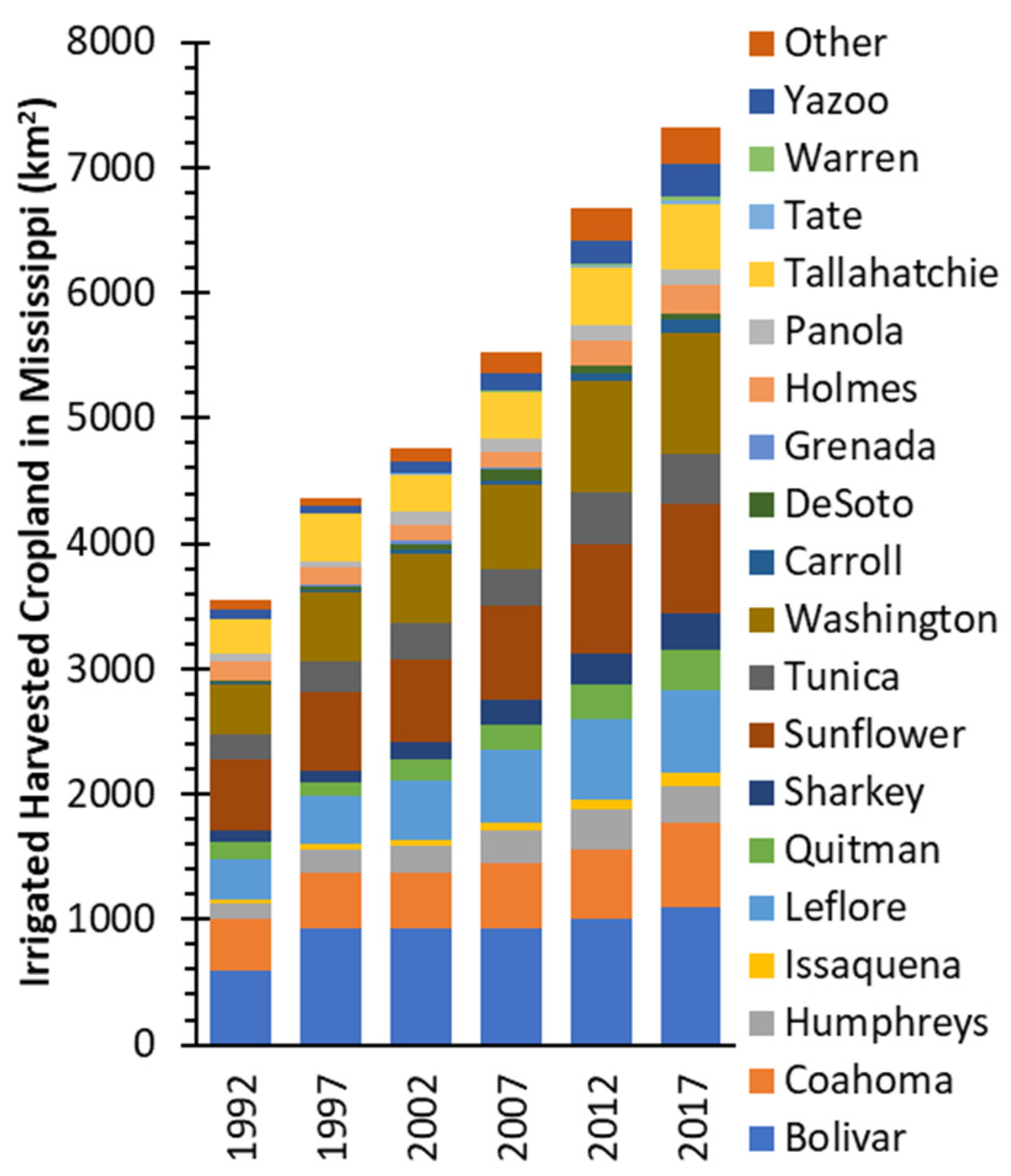


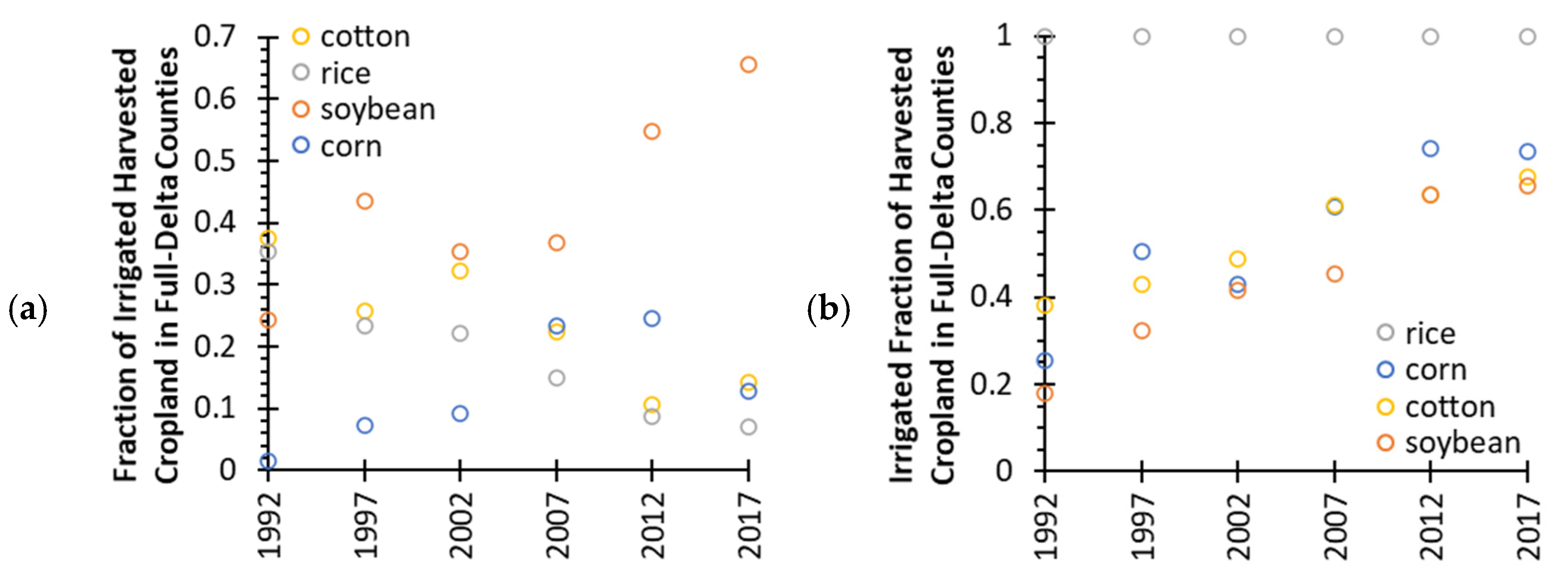

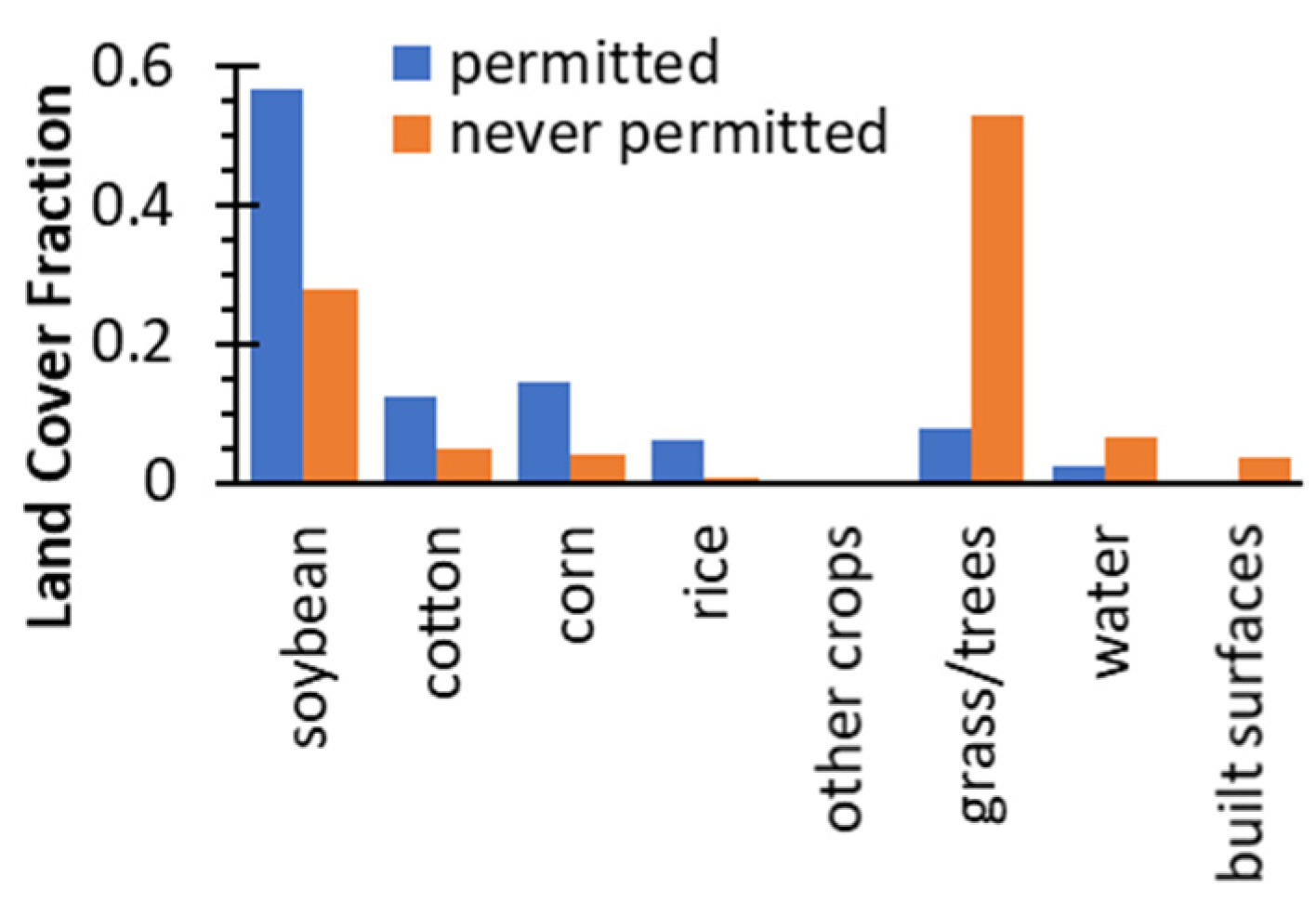

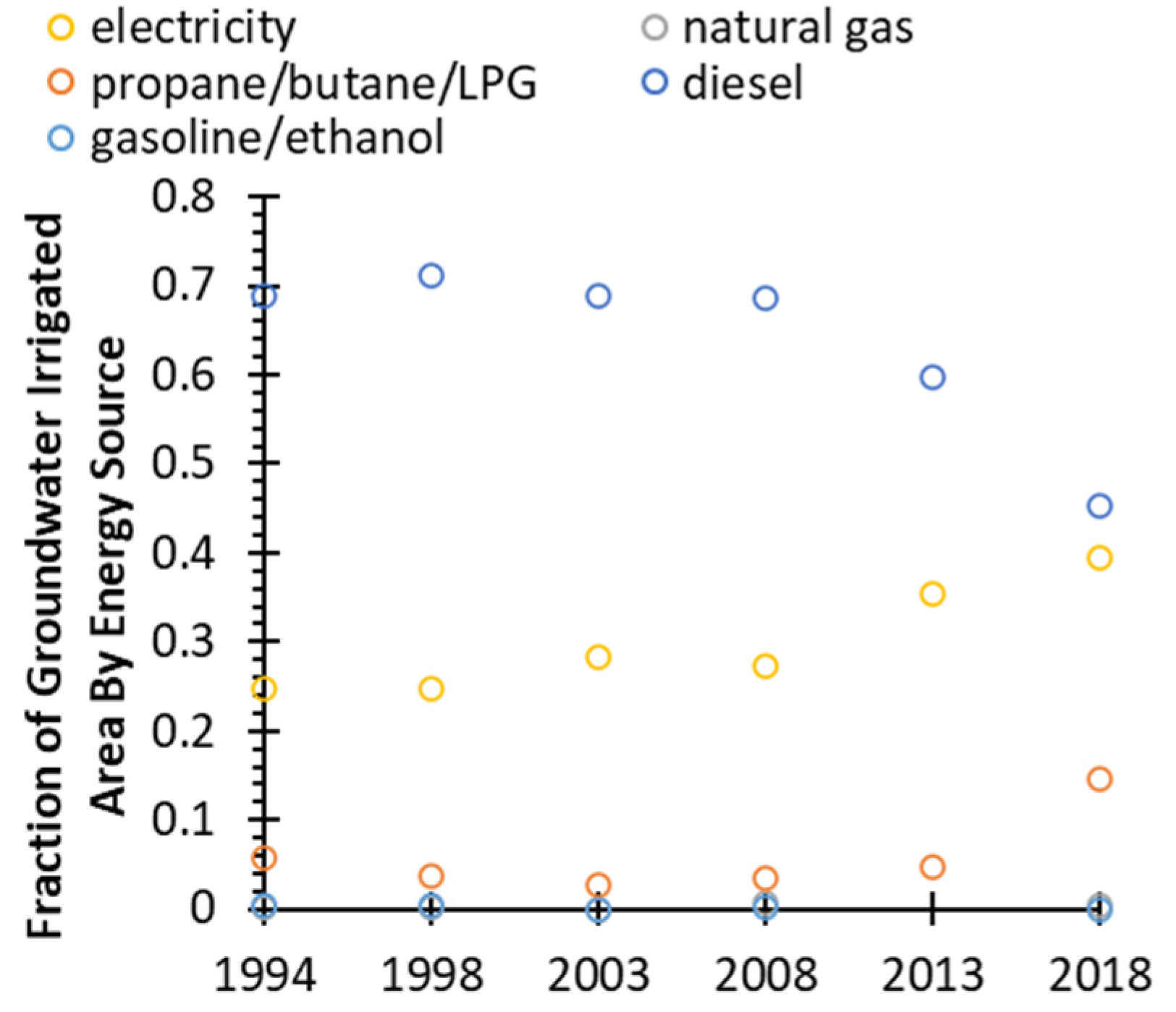
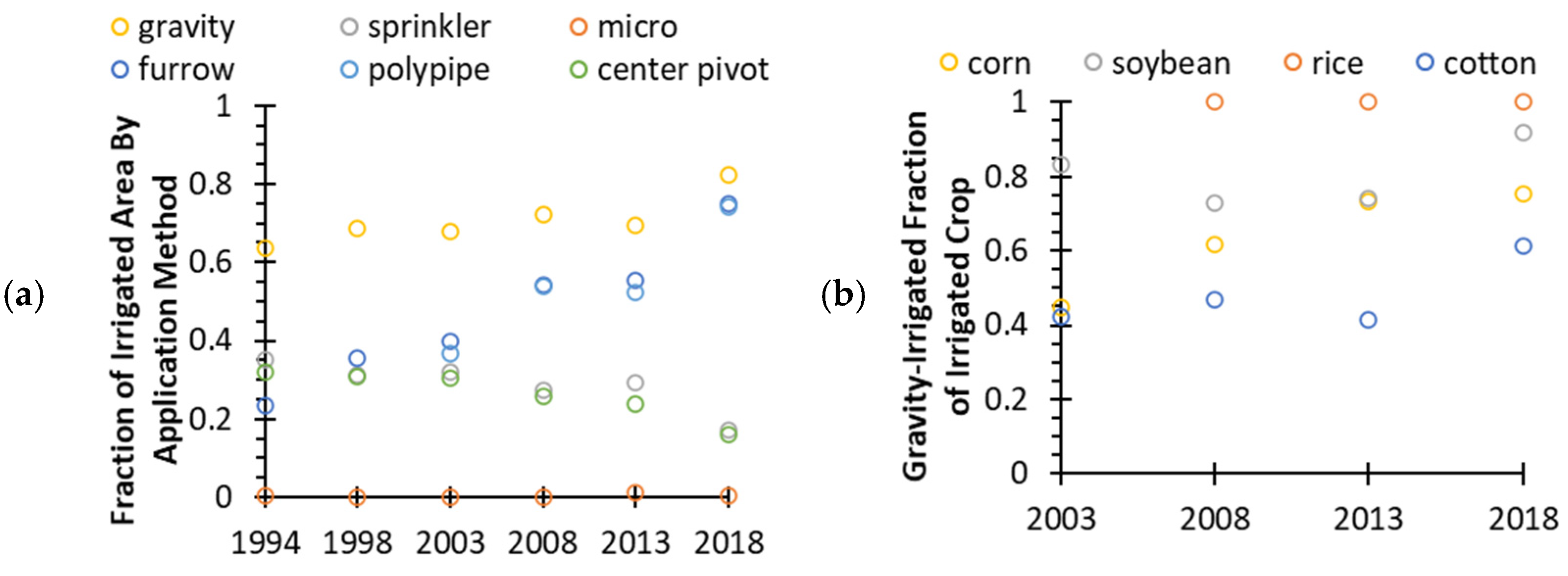
| Cover | Cropland Data Layer Codes |
|---|---|
| soybean | 5, 26, 240, 241, 254 |
| cotton | 2, 232, 238, 239 |
| corn | 1, 12, 13, 225, 226, 228, 237 |
| rice | 3 |
| other crops | 4, 6, 10, 11, 14, 21, 22, 23, 24, 25, 27, 28, 29, 30, 31, 32, 33, 34, 35, 38, 39, 41, 42, 43, 44, 45, 46, 47, 48, 49, 50, 51, 52, 53, 54, 205, 206, 207, 208, 209, 213, 214, 216, 219, 221, 222, 227, 229, 230, 231, 233, 234, 235, 236, 243, 244, 245, 246, 247, 248, 249, 250 |
| grass/trees | 36, 37, 55, 56, 57, 58, 59, 60, 61, 63, 64, 65, 66, 67, 68, 69, 70, 71, 72, 74, 75, 76, 77, 87, 131, 141, 142, 143, 152, 176, 190, 195, 204, 210, 211, 212, 215, 217, 218, 220, 223, 224, 242 |
| water | 83, 92, 111, 112 |
| built surfaces | 82, 88, 121, 122, 123, 124 |
Publisher’s Note: MDPI stays neutral with regard to jurisdictional claims in published maps and institutional affiliations. |
© 2021 by the authors. Licensee MDPI, Basel, Switzerland. This article is an open access article distributed under the terms and conditions of the Creative Commons Attribution (CC BY) license (https://creativecommons.org/licenses/by/4.0/).
Share and Cite
Lo, T.H.; Pringle, H.C., III. A Quantitative Review of Irrigation Development in the Yazoo–Mississippi Delta from 1991 to 2020. Agronomy 2021, 11, 2548. https://doi.org/10.3390/agronomy11122548
Lo TH, Pringle HC III. A Quantitative Review of Irrigation Development in the Yazoo–Mississippi Delta from 1991 to 2020. Agronomy. 2021; 11(12):2548. https://doi.org/10.3390/agronomy11122548
Chicago/Turabian StyleLo, Tsz Him, and H. C. (Lyle) Pringle, III. 2021. "A Quantitative Review of Irrigation Development in the Yazoo–Mississippi Delta from 1991 to 2020" Agronomy 11, no. 12: 2548. https://doi.org/10.3390/agronomy11122548
APA StyleLo, T. H., & Pringle, H. C., III. (2021). A Quantitative Review of Irrigation Development in the Yazoo–Mississippi Delta from 1991 to 2020. Agronomy, 11(12), 2548. https://doi.org/10.3390/agronomy11122548





